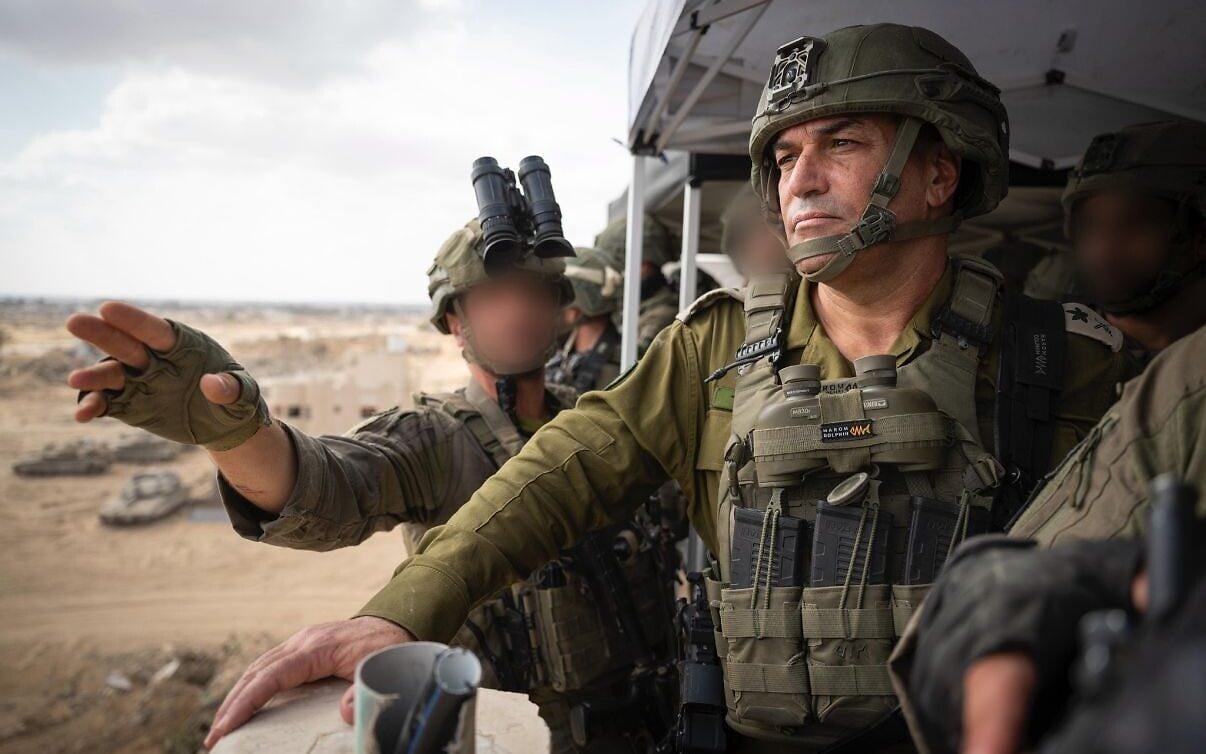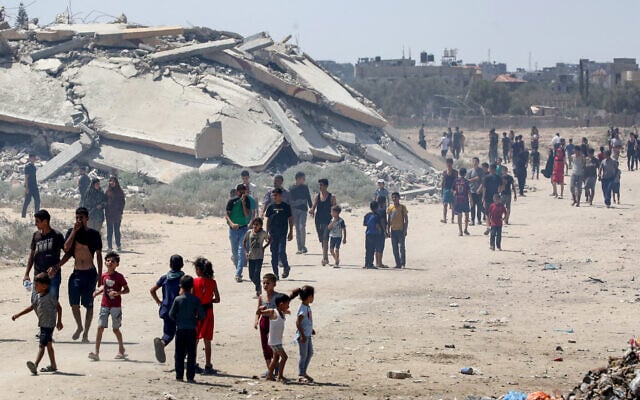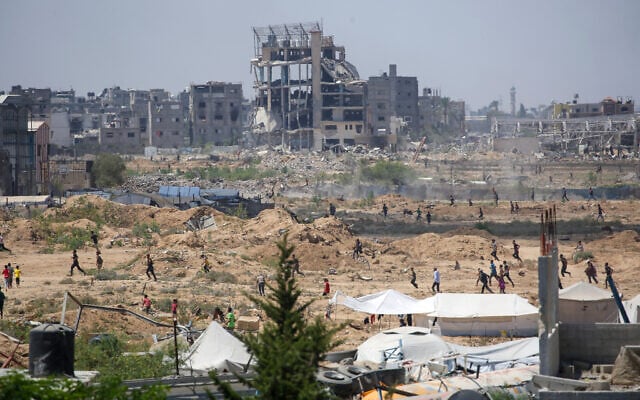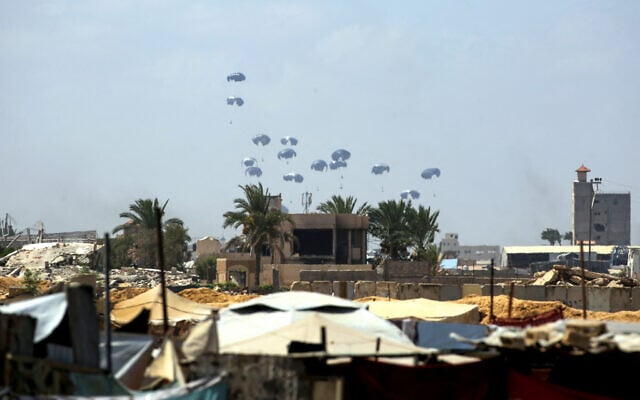



During a visit to the Gaza Strip on Sunday morning, IDF Chief of Staff Lt. Gen. Eyal Zamir said the military will approve “the plan for the next stage of the war” later in the day, as Israel gears up to expand its ongoing offensive against Hamas by conquering Gaza City.
His comments came after the security cabinet voted earlier this month to approve a military offensive in the northern Gaza Strip with the aim of defeating and capturing what Prime Minister Benjamin Netanyahu has called “the last Hamas stronghold,” which is the Palestinian enclave’s largest city.
The plans, based on a general outline green-lit by Zamir last week, were discussed at the Southern Command Saturday night.
In remarks published by the IDF, Zamir said: “Today we are approving the plan for the next stage of the war.”
“We will maintain the momentum of Operation Gideon’s Chariots while focusing on Gaza City,” he said, referring to a military offensive against Hamas that was launched in May.
“We will continue to strike until Hamas is defeated, with our eyes on the hostages. We will act with a sophisticated, measured, and responsible strategy. The IDF will employ all its capabilities on land, in the air, and at sea in order to strike Hamas with force,” Zamir said.

The IDF chief said, “Soon we will move on to the next stage of Operation Gideon’s Chariots, in which we will continue to deepen the harm to Hamas in Gaza City until its defeat.”
“Operation Gideon’s Chariots has met its objectives,” Zamir said, adding that “Hamas no longer possesses the same capabilities it had before the operation; we have dealt it a severe blow.”
Zamir said the offensive against the terror group is not “localized,” but rather part of a “long-term and planned program, with a multifront vision to strike all components of the axis, first and foremost Iran.”
The plans to expand offensive operations in Gaza comes following 22 months of war that have created dire humanitarian conditions in the enclave, and raised international alarm over the fate of the war-torn Strip, which is home to about 2.2 million people. It has also drawn sharp backlash in Israel, where relatives of hostages kidnapped by Hamas were holding a nationwide strike Sunday in protest of the plan. They are calling for an end to the war through a negotiated hostage release deal.

As part of the plan to conquer Gaza City, the military is gearing up to “relocate” the city’s residents, which some estimates put at over one million, to refugee areas in southern Gaza.
Ahead of the plan, Israel announced Saturday that it will renew the supply of tents and shelter equipment to Gaza, which has not been allowed for 26 weeks, “as part of the IDF’s preparations to move the population from combat zones to the southern Gaza Strip for their protection.”
Responding to the planned population transfer, Hamas denounced what it called a “new wave of genocide and displacement,” saying that the planned deployment of tents and other shelter equipment by Israel into southern Gaza was a “blatant deception” intended to “cover up a brutal crime that the occupation forces prepare to execute.”

Meanwhile, Israeli strikes and gunfire killed at least 18 Palestinians in Gaza on Sunday, including seven people shot while waiting to collect food aid, according to Gaza’s Hamas-run civil defense agency.
The figures could not be verified and Israel denies deliberately shooting those waiting for aid, although it says troops fire warning shots at those who endanger the forces.
Civil defense spokesman Mahmud Bassal, whom Israel has accused of being an active Hamas operative, told AFP that seven people were killed in an Israeli drone strike that hit a hospital courtyard in Gaza City, in the territory’s north.
Witnesses said the victims were members of a Hamas unit, which a source from the terror group described as responsible for distributing aid and “fighting thieves.”
Witnesses on Sunday reported Israeli airstrikes across the Gaza Strip overnight and into the morning.
Bassal said four people were killed in a strike that hit a tent sheltering displaced Palestinians in the southern area of Khan Younis, and added that Israel continued its intense bombardment of Gaza City’s Zeitoun, where troops have carried out a ground operation for the past week.
He said civil defense crews were facing “enormous difficulties reaching those trapped under the rubble” due to the ongoing violence and lack of equipment.

Meanwhile, aircraft from Jordan, the United Arab Emirates, Germany, Belgium, France, Italy, the Netherlands, and — for the first time — Denmark and Indonesia airdropped 161 pallets of humanitarian aid in the Gaza Strip on Sunday, the IDF said.
Each pallet contains around one ton of food.
Indonesia, the country with the largest Muslim population in the world, does not have relations with Israel.
Israel re-adopted a policy of allowing aid airdrops on July 26, amid mounting international criticism over the hunger crisis in Gaza. But airdrops can only deliver a small fraction of what can come into Gaza by land, and pose safety risks for civilians, who can be hit by the packages from above.
The ongoing war began on October 7, 2023, when thousands of Hamas-led terrorists invaded Israel, killing some 1,200 people and taking 251 hostages.
Terror groups in Gaza still hold 50 hostages, of whom 20 are believed to be alive, while 28 have been confirmed dead, with the government expressing “grave concern” for the remaining two.

The Hamas-run Gaza health ministry says more than 60,000 people in the Strip have been killed or are presumed dead in the fighting so far, though the toll cannot be verified and does not differentiate between civilians and fighters. Israel says it had killed some 20,000 combatants in battle as of January and another 1,600 terrorists inside Israel during the October 7 onslaught.
Israel insists it seeks to minimize civilian fatalities and says Hamas uses Gaza’s civilians as human shields, fighting from civilian areas including homes, hospitals, schools and mosques.
Israel’s toll in the ground offensive against Hamas in Gaza and in military operations along the border with the Strip stands at 459.
